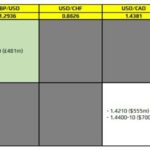
March 2025 S&P Global US Manufacturing PMI: A Cautious Growth Perspective
Tháng 4 1, 2025
Navigating the USD/JPY FX Option Expiry: Strategies for April 1, 2025
Tháng 4 1, 2025OPEC+ Oil Production Plans: Insights into Future Price Dynamics and Market Implications
Recent developments within the oil market suggest that OPEC+ is poised to gradually increase oil production beginning in April 2025. This initiative aims to reverse previous production cuts of approximately 2.2 million barrels per day that were enforced over an 18-month period. Such a decision is pivotal in shaping both the immediate and long-term landscapes of the global oil market, with significant implications for production, pricing, and overall economic stability.
Adherence to the Production Timeline and Its Challenges
While the roadmap laid out by OPEC+ indicates a clear intent to boost production, there are concerning hints that certain member countries may not strictly adhere to this timeline. This uncertainty could arise from challenges related to overproduction issues, prompting these countries to make compensatory reductions in their output. Such discrepancies could contribute to instability in oil supply and potentially disrupt the envisioned balance between supply and demand. As the global demand for oil is projected to increase significantly—anticipated to rise by about 1.4 million barrels per day in 2025, driven predominantly by robust consumption in India and China—the ability of OPEC+ to effectively manage its production levels remains critical. Notably, China’s strategic economic engagements, as discussed in this blog, highlight the country’s significant demand impact on global oil prices and market dynamics.
The Broader Price Dynamics Shaped by Geopolitical and Market Forces
Oil prices are impacted by a plethora of factors, with geopolitical tensions and supply alterations by both OPEC+ producers and non-OECD nations playing a crucial role in pricing strategies. Currently, Brent crude oil prices have been illustrating volatility, fluctuating between $68.30 and $73 per barrel as of the early months of 2025. This price behavior is reflective of not only the internal dynamics of OPEC+ but also broader market conditions, including the ongoing transition towards renewable energy.
The U.S. Energy Information Administration has projected an average Brent crude price of $74 per barrel for the duration of 2025. However, a drop to $68 per barrel is anticipated for 2026, hinting at the potential for future market pressures. Economic uncertainties stemming from global financial conditions could further complicate these forecasts, magnifying the volatility within oil markets. Analyzing neutral trends in the forex market can provide valuable insights into these economic factors affecting oil price forecasts, as explored in this blog.
Long-Term Implications of Energy Transition and Market Adjustment
Despite the optimistic projections surrounding increased demand, the shift towards renewable energy sources looms large over the future of oil prices. The market is grappling with the dual challenge of transitioning to greener energy and managing traditional oil supply streams. This transition could impose long-term constraints on oil prices, pushing them lower as the demand landscape evolves. Nevertheless, in the short term, the anticipated demand from emerging economies may sustain a degree of stability in oil prices, provided that OPEC+ can successfully navigate its production strategies without succumbing to member overproduction issues.
Furthermore, examining the analysis of the EUR/USD currency pair can shed light on the potential bullish momentum amid current market conditions, which may be critical when assessing how currency fluctuations impact oil prices and OPEC+’s production strategies, as mentioned in this blog.
As the global oil market braces for a critical juncture in 2025, the interplay between OPEC+ production plans, global demand shifts, and overarching economic uncertainties will remain key themes influencing oil prices and market dynamics. The careful monitoring of these evolving narratives will be essential for stakeholders within the industry as they seek to adapt and strategize in this ever-changing environment.
